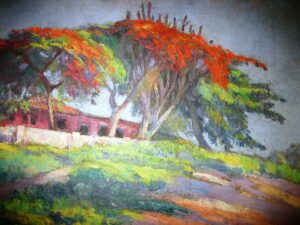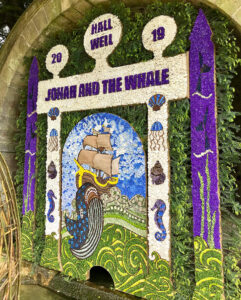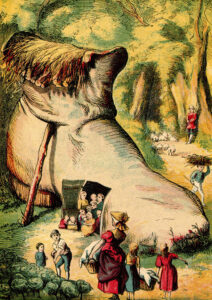Here in Lake Worth, the Royal Poinciana trees are beginning to erupt into red and orange blossoms, as they do each and every June. Of all the flowering trees here in this strange green land, the Royal Poincianas are the most majestic, the most magical, and perhaps the best reason to be in this place as summer’s heat begins to dig in its heels. Some folks call them Flame Trees, and in Brazil, I’ve just learnt, they are called Flamboyants. And our cover star for this month’s Convivio Book of Days Calendar is called just that: it’s a circa 1928 oil painting by Brazilian artist Lucílio de Albuquerque of our beloved local trees, which apparently bloom in Brazil, as well (though certainly at the opposite side of the year, as their summer approaches in December).
The June calendar may be belated this year, but luckily not much is going on, calendar-wise, until mid month, when the Feast of St. Anthony of Padua comes around. San Antonio was one of Grandma’s favorites, as saints go, and still to this day when we have misplaced something we call on him to help us find it. My most recent find was a novel I’d been reading, Under the Greenwood Tree by Thomas Hardy. I was in the final chapter last fall when suddenly the book was no where to be found. I looked and looked, and then I despaired, and then I remembered the words, “Tony, Tony, come around; something’s lost and must be found,” but Tony was slow to respond and I forgot all about it until one day last month when I was organizing the printshop and found, there behind one of the type cabinets, my book. Would I have found it without St. Anthony’s help? Possibly. I thanked him all the same and remembered the day my nephew lost a gold bracelet not once but twice at the shore of the Atlantic Ocean and both times Mom prayed to St. Anthony and both times, the bracelet was found: once washing in on the tide, and then again clinging to some sea foam covered seaweed. To be sure, Mom’s patience was tried with the second loss, and I bet so was St. Anthony’s. As for my Thomas Hardy novel, I’ve decided to start again at the beginning. Luckily, the way my mind works, it’s like I’m reading it for the first time, and the ending will certainly be a surprise as I never reached it last year. It is good, sometimes, to have a mind that resets on a regular basis.
After St. Anthony’s Day comes Bloomsday and Juneteenth and Juneteenth feels particularly important this year here in a state where books about African American history and by African American authors are being banned left and right, not to mention the fact that June is also Pride Month and the same is happening to the LGBQT community here, too. I know people who think these new laws here in Florida are not so bad but I wonder if anyone has bothered to ask the kids which they think is scarier: drag queens or active shooter drills. Let’s be honest: this is not about protecting children; it’s about silencing the voices of minorities. It began here as a K through 5 initiative but was recently expanded to Grade 12, and at the state university where I work, anything with the word Diversity attached to it has been scrubbed and the exhibition I was planning for the fall semester, an exhibition of artists’ books by John Eric Broaddus, a gay book artist who died of AIDS in 1990, has been canceled. Welcome to Florida, Land of Big Government. Here, the First Amendment only applies if you agree with the powers that be. Dissenting voices –– certainly at least half of us in this state –– are referred to as “Those People” and we find ourselves not represented at all by our elected officials for we are held up not as fellow citizens but as the enemy.
I find myself in the Those People camp because I do not agree with all these acts of restriction and suppression. And I find myself talking about this here and now because it is Pride Month. And it is not the rainbows and the pronouns that matter to me so much (I’m an English major; the pronoun thing is tough even for me, purely for grammatical reasons) but what matters to me is authenticity, and this, I think, is the value of Pride: letting people know it is ok to be themselves. Even now in my position at work I see young people who are afraid to come out to the people they love most for fear of rejection: they are afraid their parents won’t accept them. They are afraid of being disowned, afraid of being suddenly homeless, afraid of losing the love of those they love. So they sneak around pretending to be something they are not. Dishonesty is never a sound foundation for a relationship. Being open and honest with the ones you love and with the world around you: that’s what Pride is about. It’s a process I had to go through, and let me tell you: it is not easy. But it should be, and that, too, is what Pride is about. I wish all of you, no matter who you are, authenticity in your lives, and love and acceptance, and the openness to accept others for who they are.
While Pride is focused on the things of this earth, there are greater celestial events at play, too. As June comes to a close we reach the summer solstice. It is one of the few times each year traditionally considered a time of heightened magic, and you may do with that what you may. I like to seek the wonderful in life (and let’s look closely at that word: Wonderful ––> Wonder-full: full of wonder, that which is moving and surprising and astounding) and so I have always been open to the idea that there is more than meets the eye in life and that strange things sometimes still happen. Thanks to the tilt of our planet, there are two solstices each year, no matter where you are on this vast globe. In our annual circle each year around the sun, it is in June when the Northern Hemisphere reaches the apex of its tilt toward the sun, giving us our longest days. And of course the opposite is true in the Southern Hemisphere: it is December when the Southern Hemisphere reaches the apex of its tilt to the sun, when we here in the North are in winter. These points in the year have held great significance to people the world over for thousands of years. The Church gave these points in the year significance, too: to the June solstice in the Northern Hemisphere, it assigned the birth of John the Baptist, and to the December solstice, the birth of Jesus Christ. Both times have their heightened magic. Here at Midsummer, it is especially potent on St. John’s Eve, the night of the 23rd of June. It’s a wonder-full time to be alive.
While I don’t expect everyone to agree with my views on Pride Month and on the current state of affairs here in Florida, I do hope that if you disagree and wish to express this in the comments, that you will do so respectfully and with civility. For those of you who do agree with me (and perhaps even for those who don’t), here is a recent edition of Story Corps that is, I think, just perfect. It’s a 3 minute 30 second video called The Saint of Dry Creek. For me, this story really speaks to the heart of Pride: Being honest with yourself and those you love. “Don’t sneak around.”
Image: “Flamboyants” by Lucílio de Albuquerque. Oil on canvas, circa 1928, Museu Antônio Parreiras. [Public domain] via Wikimedia Commons.


